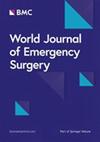Meta-analysis of the optimal needle length and decompression site for tension pneumothorax and consensus recommendations on current ATLS and ETC guidelines.
IF 5.8
1区 医学
Q1 EMERGENCY MEDICINE
引用次数: 0
Abstract
BACKGROUND Tension pneumothorax (TP) is a life-threatening condition. The immediate recommended management is needle decompression (ND), followed by the insertion of an intercostal chest drain. The European Trauma Course (ETC) and the Advanced Trauma Life Support (ATLS) guidelines differ on needle size and decompression site, creating clinical uncertainty. This meta-analysis aims to explore the optimal approach for emergency needle decompression in TP. METHODS This meta-analysis followed the PRISMA 2020 guidelines. It included English-language RCTs, cohort, case-control, cross-sectional studies, and case series with more than six patients. Studies on adults undergoing needle decompression therapy for TP or with chest wall thickness measurements were included. Ovid MEDLINE, Embase, and Web of Science databases were searched until May 31, 2024. Data were extracted, assessed for quality using OCEBM and GRADE, and analyzed using SPSS and OpenMeta with random-effects models. PRIMARY OUTCOME needle decompression failure rate. SECONDARY OUTCOMES patient demographics, cannula size, and chest wall thickness comparisons. RESULTS This review analyzed 51 studies on needle decompression for TP, with a weighted mean patient age of 36.67 years. Radiological data from 24 studies (n = 8046) indicated a 32.84% failure rate for needle penetration into the pleural cavity (I2: 99.72%). Increased needle length reduced failure rates by 7.76% per cm. No significant differences in chest wall thickness between genders were observed (T-test, p = 0.77), but thickness at the 5th anterior axillary line (5AAL) and 5th midaxillary line (5MAL) was less than at the 2nd midclavicular line (2MCL). Injury rates were higher at 5AAL than 5MAL, with strong positive correlations between needle length and injury at these sites (0.88, 0.91). CONCLUSION Based on our meta-analysis, a 7 cm needle may be appropriate for decompression of right-sided tension pneumothorax at either the 5th intercostal space along the midaxillary line or the 2nd intercostal space along the midclavicular line. For left-sided cases, given the potential risk of cardiac injury, the 2nd midclavicular line is a safer option. However, these recommendations should be interpreted with caution due to considerable heterogeneity among the included studies, potential risk of bias, and variability in measurement techniques. Clinical decisions should always be individualized, taking into account patient-specific factors.张力性气胸最佳针长和减压部位的meta分析,以及对当前ATLS和ETC指南的一致建议。
背景:张力性气胸(TP)是一种危及生命的疾病。立即推荐的处理方法是针减压(ND),然后插入肋间胸腔引流管。欧洲创伤课程(ETC)和高级创伤生命支持(ATLS)指南在针的大小和减压部位上存在差异,造成临床不确定性。本荟萃分析旨在探讨急诊TP针减压的最佳方法。方法本荟萃分析遵循PRISMA 2020指南。它包括英语随机对照试验、队列、病例对照、横断面研究和6例以上患者的病例系列。研究对象包括接受TP针减压治疗或胸壁厚度测量的成人。Ovid MEDLINE, Embase和Web of Science数据库被检索到2024年5月31日。提取数据,使用OCEBM和GRADE评估质量,并使用SPSS和OpenMeta随机效应模型进行分析。主要结局:针头减压失败率。次要结局:患者人口统计学、插管大小和胸壁厚度比较。结果本综述分析了51项关于TP针减压的研究,加权平均患者年龄为36.67岁。24项研究(n = 8046)的放射学资料显示,胸膜穿刺失败率为32.84% (I2: 99.72%)。增加针长,每厘米故障率降低7.76%。两性胸壁厚度差异无统计学意义(t检验,p = 0.77),但第5腋前线(5AAL)和第5腋中线(5MAL)胸壁厚度小于第2锁骨中线(2MCL)胸壁厚度。5AAL损伤率高于5MAL,针长与这些部位的损伤呈显著正相关(0.88,0.91)。结论根据我们的meta分析,在沿腋中线的第5肋间隙或沿锁骨中线的第2肋间隙进行右侧紧张性气胸减压,7 cm针都是合适的。对于左侧的病例,考虑到心脏损伤的潜在风险,第二锁骨中线是一个更安全的选择。然而,由于纳入的研究存在相当大的异质性、潜在的偏倚风险和测量技术的可变性,这些建议应谨慎解释。临床决策应始终是个体化的,考虑到患者的具体因素。
本文章由计算机程序翻译,如有差异,请以英文原文为准。
求助全文
约1分钟内获得全文
求助全文
来源期刊

World Journal of Emergency Surgery
EMERGENCY MEDICINE-SURGERY
CiteScore
14.50
自引率
5.00%
发文量
60
审稿时长
10 weeks
期刊介绍:
The World Journal of Emergency Surgery is an open access, peer-reviewed journal covering all facets of clinical and basic research in traumatic and non-traumatic emergency surgery and related fields. Topics include emergency surgery, acute care surgery, trauma surgery, intensive care, trauma management, and resuscitation, among others.
 求助内容:
求助内容: 应助结果提醒方式:
应助结果提醒方式:


